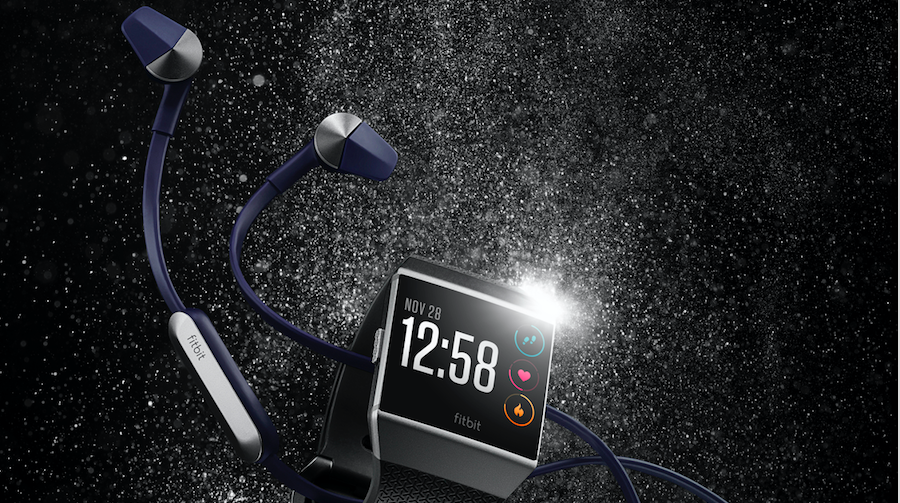At the Deutsche Bank Technology Conference, William Zerella, Fitbit’s CFO, said that while the recent launch of the Apple Watch Series 3 caught some buzz, Fitbit’s first smartwatch, Ionic, is ready to compete in the space.
Zerella stressed that Apple is “always relevant” and will “certainly sell their device.” He also said its’ “hard to say” how much market share Fitbit will be able to command in the crowded smartwatch space.
But the CFO said health & fitness continues to be a “very big driver” of the purchase decision around smartwatches. Apple’s smartwatch may contain about 19,000 apps, but the average person uses three or four and they’re mainly tied to notifications and health & fitness, Fitbit’s core positioning. Said Zerella, “We think our brand is going to resonate because we’re a healthy & fitness-first focused company.”
He added that while Apple’s built-in cellular capabilities with its LTD model may be attractive to some consumers, he’s not sure how many are going to want to run or go out without their smartphone. Zerella added, “Most of us we don’t go anywhere without our phones.”
Moreover, at $400 plus an extra $10 a month to support a phone plan, the Apple’s LTD version “starts to get a little pricy.”
Zerella said Fitbit has learned there’s “lots of price sensitivity” around wearables. Said the CFO, “For those of us who are in the upper quartile of earnings we might not think about it that way, but the average American makes $58,000 a year.”
Fitbit found there’s “an enormous amount of price sensitivity” around fitness trackers and “ultra-price sensitivity” on the health care side. Zerella added, “Our strategy is to make sure we have a broad enough product line so that no matter what the consumer is interested in we’ve got a product for them.”
Another factor that would work in Fitbit’s favor is its support of the Android platform. Globally, 80 percent of smartphones are Android-based. IOS has 45 percent share in the U.S., 30 percent in Europe and only 10 percent in Asia. Said Zerella, “The Android market is certainly a big opportunity and we will certainly get a piece of a IOS market as well.”
Zerella suspects Fitbit will gain a “mixture of new customers and existing users” who will purchase the Ionic. Recently, 40 percent of Fitbit’s activations have come from existing users. The Ionic replaces the Surge but the CFO also expects fans of the Blaze, at $200, may upgrade to the $300 Ionic with its expanded features. The Blaze, launched in January 2015, has “sold millions” and Fitbit is ramping up production to meet demand.
Overseas, Zerella is optimistic about Ionic’s growth in Europe because smartwatches are just catching on there and it has a large number of Android smartphone users. In China, Fitbit hasn’t been able to break through with its trackers in part because of many low-priced trackers in the region. But the Ionic launch includes a branded partnership with Adidas that should help Fitbit secure a foothold for at least its Ionic smartwatch. He noted that Adidas has 1,000 Adidas stores in China, 200 of which are company owned. Said the CFO, “You have to think there’s subset of consumers willing to spend more money for a compelling product.”
On the health care side, Zerella said that with its “unlimited cash, [Apple] can basically do whatever they want.” But he also believes Fitbit’s health & fitness focus and community, ability to work with both Android and IOS devices, and price points offer some advantages.
Zerella added that Fitbit and the broader health community are still trying to “understand what’s possible” in wearables addressing the health care opportunity.
The opportunity remains reducing the $600 billion spent a year on the nation’s five leading chronic diseases: diabetes, heart disease, arthritis, depression and cancer. Activity levels, sleep and diet impact all five of the diseases in “some very obvious and some less obvious” ways and the hope is that fitness & health tracking can be serve as a “path to manage these disease states.”
In one of its bigger steps in health care, Fitbit on September 8 announced it was partnering with Dexcom, a company that creates continuous glucose monitoring (CGM) devices for people with diabetes. The pairing brings Dexcom’s monitoring device data to the Ionic smartwatch.
Overall, Zerella saw that Apple’s increased commitment with its third smartwatch underscores strong demand and growth potential for the smartwatch category.
“You’ve got the largest tech company in the word saying that this is the space we want to invest in,” said Zerella. “We think we’re way past the point of this being a fad. Now it’s a matter of form factors, pricing and feature sets and all those kinds of things. But clearly this is a space that’s here to stay and the opportunity is really there to get more and more penetration of the population over time.”
Photo courtesy Fitbit
















